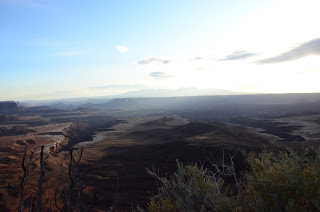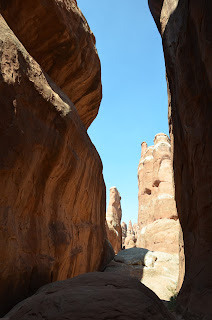One unexpected bonus was a family of long horn sheep
grazing at the side of the trail. We saw them nudging each other with their
horns and watched as the baby of the group, complete with fuzzy horn nubs, showed
its age by its unsteadiness on its feet as it dislodged a shower of little
rocks. We were grateful to encounter them as we descended, as they promptly
blocked the trail behind us and delayed the hikers who were returning to the
rim.
 |
| See the little baby in the middle? |
Our time at the canyon complete, we repacked the car and
headed to the stop most prized by the trip’s engineer: the Hoover Dam. This
gigantic dam – the largest in the country – holds back the flow of the Colorado
River, allowing water management strategies that steadied the water supply to
the region, allowed the growth of Los Angeles, and supported 80% of the winter
produce grown in the United States. As if that weren’t enough, it’s also a huge
source of hydroelectric power, as evidenced by the tangles of power lines
running up both sides to Arizona and Nevada. Josh was in awe, and I will admit
I was pretty impressed.
Our tour of national parks and engineering marvels
complete, we ventured to a different kind of national landmark – Las Vegas. In
addition to being completely overwhelming after a week spent in the woods, Las
Vegas is impressive in its ambition. The hotels are larger than you ever
dreamed they would be. They offer every convenience, working to ensure people
never need to leave their doors. Restaurants, alcohol, and slot machines at
every turn? Child’s play. How about tattoo parlors, IV hydration centers (for
your hangover – or as a precaution!), oxygen bars, fine art galleries, and
100-oz alcohol cups that dangle from a lanyard? Walking the strip at night is
like walking through an endless Times Square, with buildings clad in screens
advertising six different Cirque du Soleil shows (including an 18+ only
version), shows by seemingly every winner of America’s Got Talent, and rock and
pop acts from the '70s through today. Locals full of hustle shove paper
advertisements or free entry coupons into your hand as you pass, and girls
dressed in whatever skimpy combination of fishnets, feathers, and rhinestones
they could find offer pictures for a price. Restaurants compete with
attractions as much as with food, from a humongous beach chair out front for
that perfect photo to the world’s largest Pac Man game (seizure warning clearly
stated). It is a city ready to please, ready to fulfill your every whim or
desire with exemplary convenience.
Josh and I checked in after a marathon walk through rows
of slot machines, gambling video games, and poker tables. Hotel rooms are
relatively cheap in Vegas, as they make their money other ways once you get
there. We meandered down the strip on our way to our main event: dinner. Since
we don’t gamble, didn’t find any shows that piqued our interest, and had been
surviving on PB&Js and Costco bulk snacks for most of our meals, we decided
to indulge in a really nice dinner. After three hours at Joel Robuchon’s
namesake restaurant, I can confirm that it was totally worth it. I have learned
that any restaurant with a dedicated bread guy is going to rank well on my
list, and this restaurant had a bread guy and a butter guy. Every dish was just
right – unexpected pairings that added richness or crunch or contrast in all
the right places. Plus, Josh and I learned that when you want to have multiple
dessert courses, you just call the first one a “palate cleanser” and nobody
looks at you funny.
On our way home, we strolled past the Bellagio to enjoy
the water show – a sweet and simple way to end the evening.
Spotted: Over the top hotel décor, courtesy of the
Bellagio.
 |
| Chihuly glass on the ceiling of the Bellagio lobby |
 |
| A strange exhibition with mechanical animals covered in flowers, stones, chickpeas, and quinoa (among other things) in the Bellagio. |































































